Is Google Collaborative Inbox Right for Your Team?

Table of contents
For decades, businesses have relied on email to communicate with customers and resolve their queries.
But managing customer queries across a team is anything but simple. Who’s replying to what? Has anyone already responded? Is any email being missed? Before long, things get messy.
In the early days, teams relied on a “one-size-fits-all” workaround: sharing login details. You’d have one common inbox (say info@ or support@) and everyone from the team would log into this inbox to access customer emails. It seemed practical at first, but this approach came with its own set of problems—confusion, missed responses, and glaring security risks. As email providers began clamping down on account-sharing, teams were left scrambling for a better approach.
Google then stepped in with Collaborative Inbox, a feature designed to help teams manage shared email addresses in a structured way. It introduced features for assigning emails, tracking email status, and keeping everyone on the same page.
At first glance, the Google Collaborative Inbox might seem like an ideal solution for small teams or businesses looking for a free tool to collaborate and get visibility on emails. But is it really what your team needs? Let’s take a closer look.
Table of Contents
- What is a Google Collaborative Inbox?
- How to Set Up a Google Collaborative Inbox for Your Team?
- Pros and Cons of Google Collaborative Inbox
- 5 Best Alternatives to Google Collaborative Inbox
- Frequently Asked Questions (FAQs)
- Your Team Deserves Better Than Google Collaborative Inbox!
What is a Google Collaborative Inbox?
A Google Collaborative Inbox is a feature within Google Groups that’s designed to help teams assign, track, and share email conversations more effectively.
Let’s assume you have a shared email address like support@ or info@ that multiple employees have access to. Instead of getting everyone to log into the same email account, which can get messy and also raises security risks, you use a Collaborative Inbox.
Here’s how it works:
If a customer sends an email to [email protected], it arrives in the Google Collaborative Inbox. Here, team members can view, assign, and track all incoming emails. In this case, you can assign the customer query to a specific team member. Once it’s resolved, it can be marked as complete, so that the team knows it’s taken care of.
Google Collaborative Inbox is available for free for Google Workspace users.
How to Set Up a Google Collaborative Inbox for Your Team?
Step 1: Create a Google Group
First, you need a Google Group. This is because the Collaborative Inbox feature works within Google Groups.
- Go to the Google Groups page and sign in with your Google Workspace account.
- Click on “Create Group.”
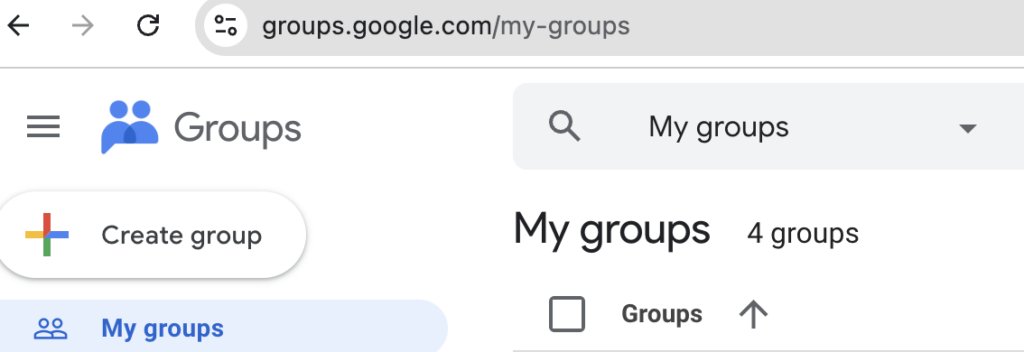
- Next, fill out your group details. Make sure to choose a group name that reflects the purpose of your inbox. Avoid generic names like “Team Inbox” to prevent confusion if you have multiple group emails. In this image, I have shared an example of how you can add your Group details.
- Click on “Next” to move to the permissions section.
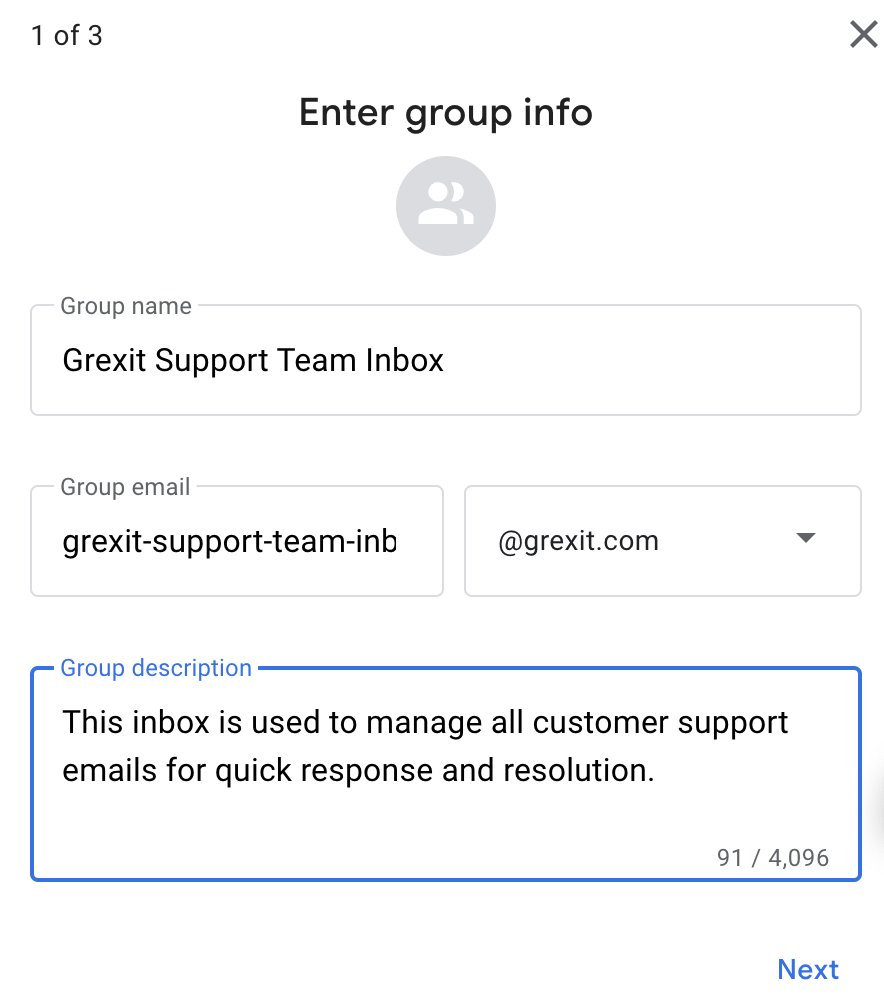
Step 2: Set Permissions for Your Group
Permissions are crucial for deciding who can access and use the inbox.
- Under Who can join the group, select either: “Only invited users” (ideal for internal teams),or “Anyone in your organization” for broader access within your company.
- Adjust permissions for posting messages and viewing conversations. Below is an example; change it as per your preference:
– Set “Who can view conversations” to “Group members.”
– Set “Who can post” to “Group members.”
– Set “Who can view members” to “Group members.” - Click Next
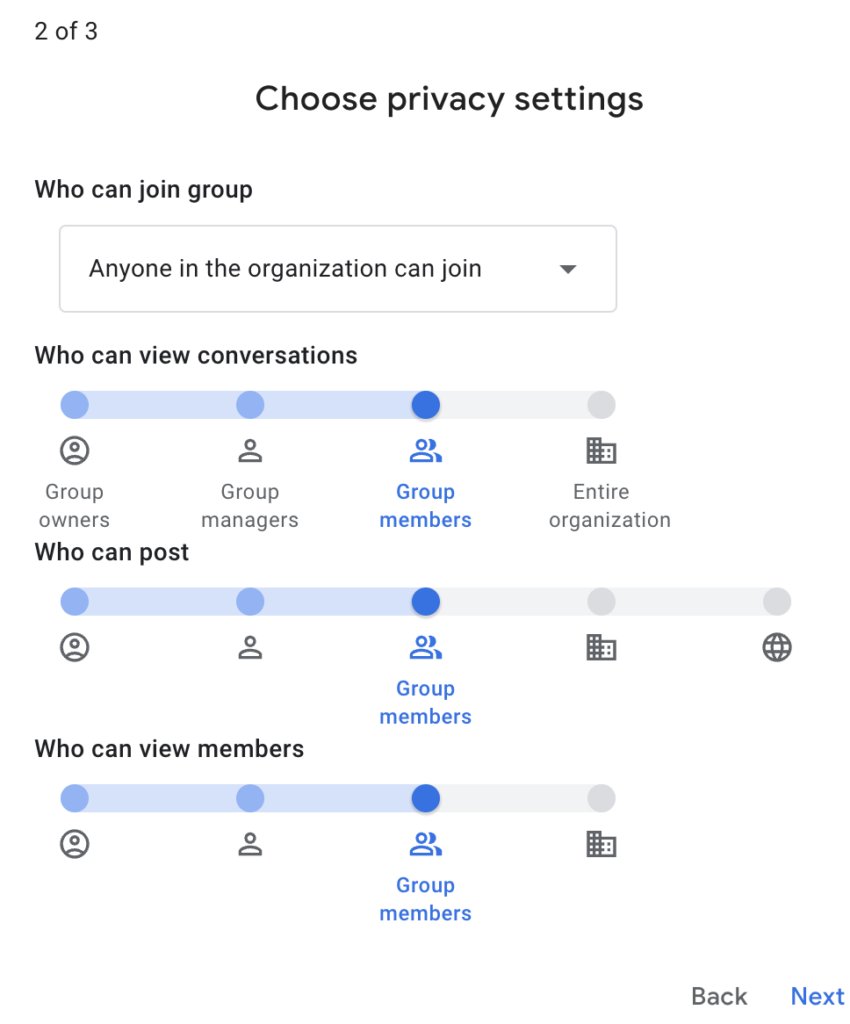
Step 3: Add Members to Your Group
This is where you define the roles and set up how members will interact with the group.
- In the “Group Members” field, add the email addresses of team members who will actively work in the Collaborative Inbox.
- The “Group Owner” field is dedicated to the person managing the group. Think of it as one level above “Group Managers.” By default, the person creating the group (you) becomes the owner, but you can add others if needed. Owners have the highest level of control and can delete the group if necessary.
- Use the “Welcome Message” section to send a message to all new group members when they’re added.
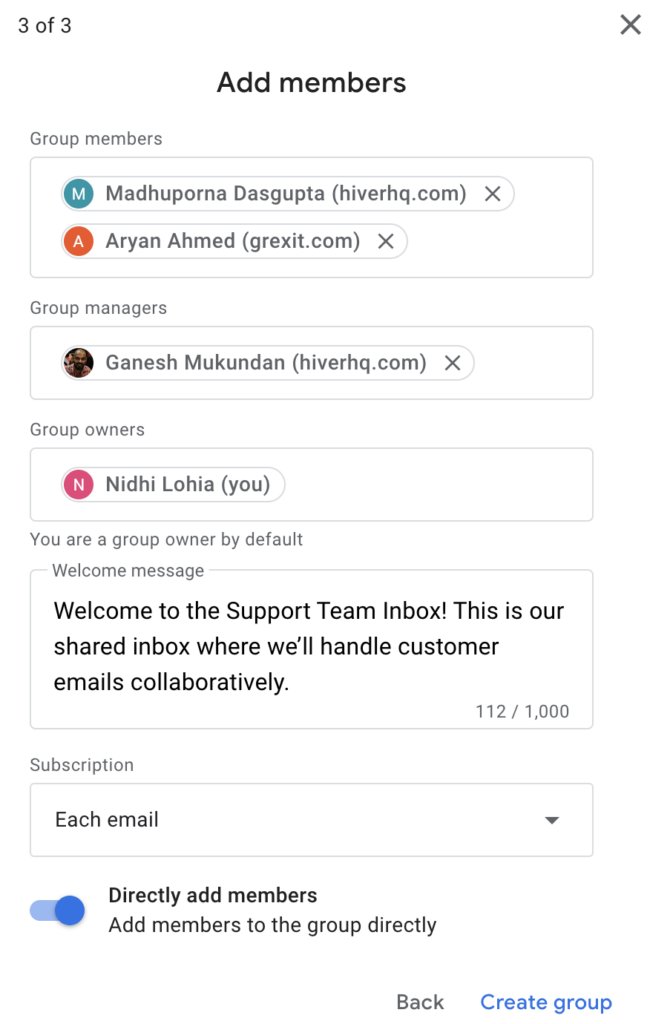
In the “Subscription” section, set how many members receive group emails:
- Each Email: Members receive every email as it comes in.
- Digest Email: Members get a summary of emails (once daily).
- Abridged Email: Members receive a condensed version of email activity.
- No Email: Members won’t receive any emails directly but can access them in the Collaborative Inbox.
Once you’ve filled out all the details, click “Create group” to complete this step. You’ll now see the group in your dashboard.

Step 4: Activate Collaborative Inbox Features
Following these steps will fully activate and optimize your Collaborative Inbox for your team’s workflow.
- On the group page, look for the “Group Settings” option in the left-hand panel and click on “General.”
- Find the option labeled “Enable additional Google Groups features” and then select “Collaborative Inbox.” Doing this unlocks features like assigning conversations, marking messages as resolved, and tracking email statuses.

Activate Collaborative Inbox
Once the Collaborative Inbox is enabled, you’ll see some additional options. Customize them based on your team’s needs.
- Turn on Conversation History: It’s helpful to keep track of past conversations. Make sure this option is enabled.
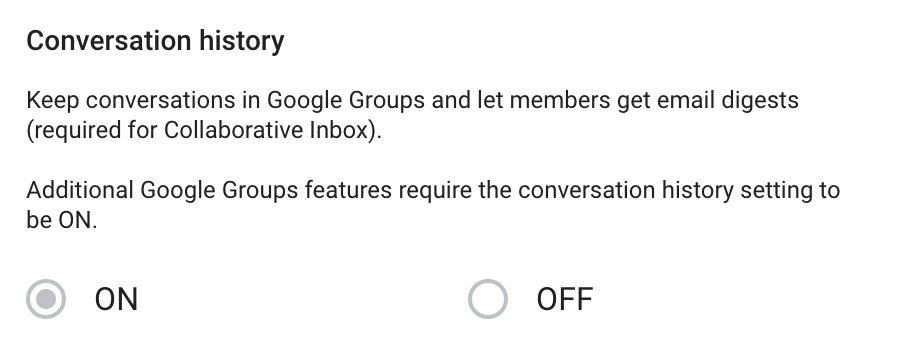
- Define member permissions: Go to “Member Moderation” and adjust your settings to determine who can add, remove, or modify members in the group.
- For Collaborative Inbox, allow Managers or Owners to manage members. This ensures only trusted individuals can control group access, which is important for maintaining email security and preventing unauthorized access.
- As for “Who can modify custom roles” assign this ability to Managers or Owners only. This ensures consistency in roles and permissions and prevents members from accidentally changing critical access settings.
- The “Create Custom Role” option allows you to define unique roles with specific permissions for members. It’s particularly useful in Collaborative Inbox setups where different team members have distinct responsibilities.

Why Custom Roles matter:
- They ensure members only have the access they need to perform their specific tasks, reducing errors and confusion.
- Custom roles also make it easier to onboard new members by assigning them limited permissions initially.
- By using custom roles strategically, you can streamline your Collaborative Inbox workflow and make sure that everyone’s responsibilities are clearly defined.
Step 5: Start Using Your Collaborative Inbox
After all these settings, you can now make the best use of your Collaborative Inbox.
- When an email lands in your Collaborative Inbox, you can assign it to yourself or a teammate.
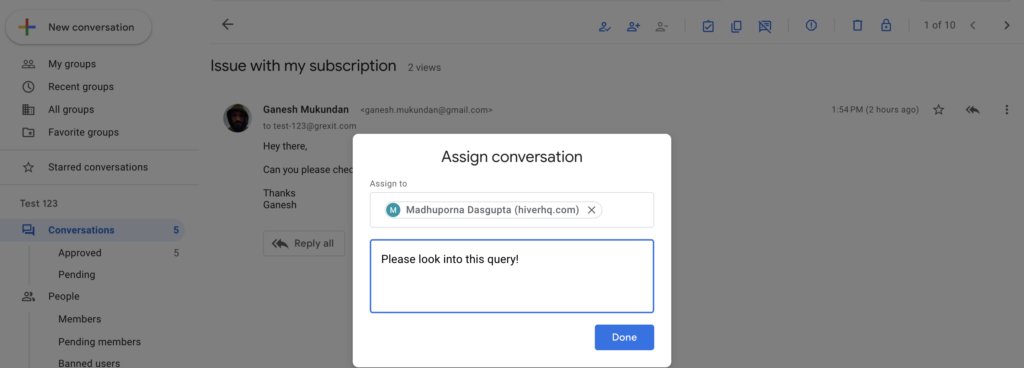
- As you or your teammate work on it, you can update its status right from the inbox—mark it as complete, duplicate, or no action needed.

- Team members can also leave comments or notes within each email thread. This way, everyone stays informed about ongoing tasks.
Pros and Cons of Google Collaborative Inbox
Here’s a quick comparison of the pros and cons of using Google Collaborative inbox.
| Pros | Cons |
| Centralize all emails in one place. No communication gets missed. | Interface is not intuitive and looks entirely different from Gmail, making it hard to navigate. |
| Seamlessly integrates with Gmail and other Google apps like Drive and Calendar. | Internal collaboration is via forwards and CCs, leading to more email clutter. |
| Emails can be marked as ‘completed’ or ‘no action needed’, ensuring visibility for all. | No visibility into what team members are working on. |
| Ideal for small teams needing basic email collaboration without additional software costs. | No insights into team performance metrics like response time or ticket resolution time. |
Advantages of Using Google Collaborative Inbox
Using a Google Collaborative Inbox can offer several advantages, especially for teams that are client-facing and have a group email such as support@ or info@ for stakeholders (customers, vendors, or prospects) to reach out.
1. Centralized Communication
One of the biggest benefits of a Google Collaborative Inbox is that it helps centralize all communication in one place. Instead of having emails scattered across multiple personal inboxes, everyone on the team can access the same set of conversations.
For example, let’s say your team receives a lot of customer inquiries. With a Collaborative Inbox, your team members can see all incoming emails without needing to forward them or Cc relevant colleagues. This way, nothing gets lost, and everyone stays informed about ongoing conversations.
2. Integration with Gmail and Google Workspace
Since Google Collaborative Inbox integrates seamlessly with Gmail, team members can receive notifications directly in their Gmail accounts. This means they don’t have to constantly switch to the Collaborative Inbox to see what’s happening; they can stay updated on their tasks right from their personal email interface.
Also, the Collaborative Inbox integrates seamlessly with other Google applications like Drive, Docs, and Calendar. For instance, a team member can attach a relevant Google Doc to an email thread, providing necessary context or information.
3. Accountability and Tracking
After resolving a customer issue, you can mark it as completed, duplicate, or no action needed – right within the inbox. This gives everyone visibility into what has been addressed and what still needs attention.
Disadvantages of Using Google Collaborative Inbox
Despite the benefits mentioned above, the Google Collaborative Inbox can be rather limiting for slightly larger teams wanting to achieve more than just collaboration.
1. Google Collaborative Inbox’s interface is complex to navigate
The Google Collaborative Inbox UI looks nothing like Gmail. It was not designed to work as an email client in the first place. It’s an entirely new interface that looks completely different from any other Google application.
Your team will have to spend a lot of time just getting used to it. The UI is not intuitive like Gmail (I love Gmail. I am sure you do too!).
On top of that, they will have to keep swapping between their Gmail inbox and the Google Collaborative Inbox — there is a good chance a few emails will fall through the cracks.
I recently stumbled upon a Reddit thread titled, “Struggling with Google Groups Collaborative Inboxes – Am I Doing It Wrong?” The user was asking:

Here’s the issue this user is pointing out with Google Collaborative Inbox:
When you receive a customer email and click “Reply all,” the recipient (customer) email address goes to the Cc field. Also, if you notice in the image below, you can only respond from your personal email ID and not from the group email.

2. Internal communication becomes a hassle
No matter which team you are a part of – sales or customer service – seamless team collaboration is crucial to getting work done effectively.
Sometimes you’ll even have to collaborate with other departments for various reasons. However, for Google’s Collaborative Inbox users, neither internal nor cross-functional collaboration is easy. You mostly have to rely on long email threads, CCs, and forwards. As you can see in the image below, the only way to loop in a colleague is to forward the email.

3. You will have a hard time finding the status of emails
Let’s assume you’re doing customer support from Gmail, and you start using the Google Collaborative Inbox.
A customer email arrives, and one of your teammates replies to it from their personal inbox. Unless that person has copied the group email address in the reply, the response will not be visible for everyone else on the group.
Let’s say that person did remember to copy the group email address in the reply, but the customer does a ‘reply’ and not ‘reply all’ — it again comes to just one person. You and the rest of the team will always be in the dark about the status of emails.
An example to illustrate this: There’s a customer who has reached out with an issue related to their subscription. You respond to their email saying you’re working on a fix but you forget the Cc the group email address. Your response won’t be visible to your team members in the Google Collaborative Inbox. There’s a good chance they assume that this customer email is yet to be responded to.
4. There’s enormous room for duplication of work
When you and your team don’t know if an email has been replied to, there is a good chance someone else might start working on it.
Imagine you’re running a sales team using the Collaborative Inbox in Google Workspace, and two sales executives end up replying to the same prospect. You’ve ruined your first impression right there. For all you know, you’d lose the client for being unprofessional.
The same applies to customer support teams. An email arrives, and two people start working on it at the same time. And then, both of them reply to the same customer — you’re essentially saying the same thing to the customer twice.
Even when you’ve assigned the email to an individual, the rest of the team would not know about it. To them, the email looks unattended unless they see a reply.
I came across another Reddit user’s issue about using Google Groups as a Collaborative Inbox. Here’s what they said:

This is a common challenge with Google Collaborative Inbox. Since responses often come from individual email addresses (not the group address),it can cause confusion and messy threading in personal inboxes.
5. You’ll not be able to measure team performance
When you run your support or sales, it is absolutely important that you know how efficient your team is at handling emails.
But with a Google Collaborative Inbox, all you’d be able to track is the number of emails received and sent.
You have no way of knowing the level of efficiency your team is working at. For instance, you will have no answers to (a) the average first response time, (b) the average time to close a ticket, or (c) who in your team needs more training.
5 Best Alternatives to Google Collaborative Inbox
By now, it’s clear that Google Collaborative Inbox has its limitations. The hard truth? It’s not really designed for handling sales, support, or anything that requires true team collaboration. That’s why so many people are constantly on the lookout for better alternatives.
I even came across a Reddit thread where someone asked:
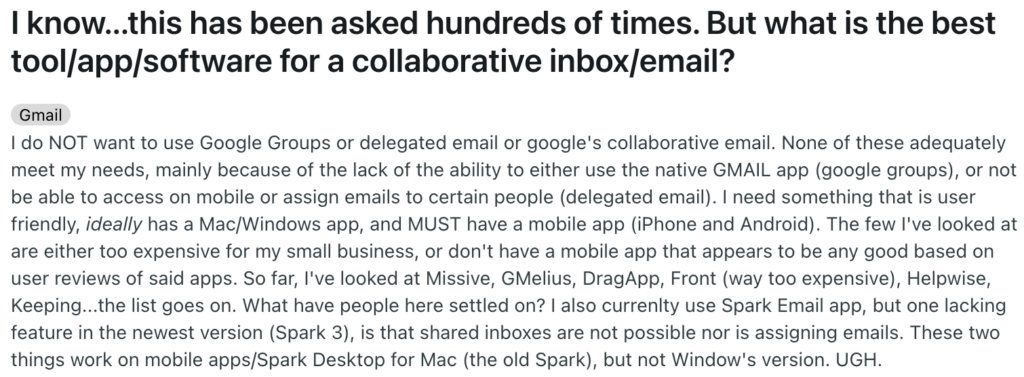
It’s a valid question because teams need tools that actually help them work together seamlessly. So, I’ve put together a list of some of the best alternatives to Google Collaborative Inbox—and why they stand out. But first, let’s do a quick comparison.
| Tool | Key Features | Starting Price |
| Hiver | – Works inside Gmail and Outlook – Email assignment for clear ownership of tasks – Internal notes and @mentions for collaboration – Analytics to monitor team performance | $19/user/month. Forever-free plan is available |
| DragApp | – Task management with due dates and checklists – Tracks email opens and provides customizable views – Integrates seamlessly with Google Workspace | $8/user/month |
| Zendesk | – Ticketing system for handle customer inquiries – Supports multiple channels (email, chat, phone) – Automation tools for workflows and auto-responses | $45/user/month |
| Front | – Unified inbox for email, SMS, and social media messages – Assignment and internal comments for collaboration – Automation rules to streamline workflows | $19/user/month |
| Help Scout | – Reporting tools to track email response and resolution time – Automated workflows and templates for faster responses – Offers live chat and in-app messaging | $55/user/month. Free plan is available. |
1. Hiver
Hiver turns your Gmail and Outlook into a fully-fledged shared inbox with powerful features. This means you can manage your work emails and shared inbox emails (queries from customers and other stakeholders) without switching tabs.
Unlike with a Google Collaborative Inbox, teams can use Hiver to assign emails to team members, leave internal notes, track the status of conversations, and get complete visibility into everyone’s workload. It’s built to make email collaboration simple and efficient, especially for teams handling customer support, sales, or finance.
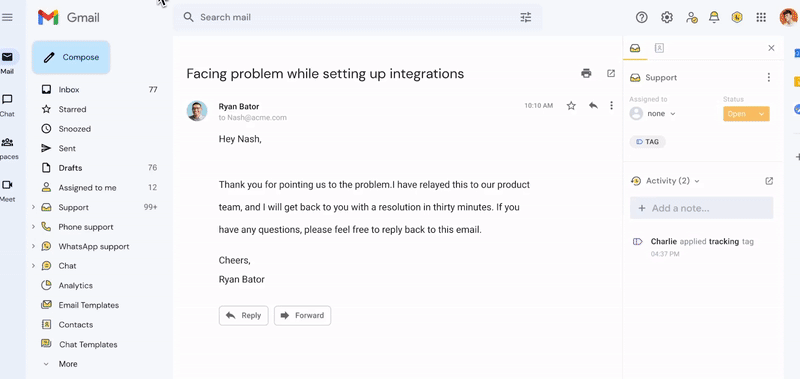
Key Features:
- Effortlessly delegate emails to your team (without forwarding): Hiver lets you assign emails to your teammates without having to forward them. All it takes is two clicks from the Gmail sidebar. The assignee gets notified in real-time about it.
- Know the status of all emails: Track the status of every email in your shared mailbox: open, pending, or closed. Hiver also helps you classify emails into distinct categories: unassigned, mine, team, pending, and closed. This gives you a clear picture of all workload, and ensures no conversation gets missed.
- Email tags: Organize your emails by adding tags to categorize them based on type or priority. Use these tags to quickly filter conversations and find the information faster. You can even customize and color-code the tags for better visibility and easier organization.
- Make internal discussions easy: Hiver lets your team communicate internally using Email Notes, which are like chat messages that appear right beside the email thread.
Using notes, you can communicate with anyone across your company. Notes come in handy for a host of things:
- You want to broadcast a question to everyone in your team. Start the note with ‘@all’, and anyone in the group can now reply to your note.
- You want to reach out to a specific person. Start the note with @name, and only that person will get notified. You can then exchange messages with that person like you would on personal chat.
- You want to add some context or learning to the email which you think might come in handy in the future. Just write it down as a note, and it will stay alongside the email.
Basically, you and your team write fewer emails when you use Hiver’s Notes. You can completely eliminate internal emails if you use Notes the right way.
- Powerful reporting and analytics: When you run sales or customer service from Gmail, it is absolutely pertinent that you keep a keen eye on how well your team is dealing with emails. With Hiver, you have access to all vital conversation metrics – first response time, average resolution time, and more.

That’s not all. You can do a lot more!
- Automate key actions like assigning emails and live chat messages based on preset rules.
- Save combinations of email filters as views (such as all emails that Cynthia is yet to work on).
- Save canned responses as email templates. Share them with your team to provide faster resolutions to frequently asked questions.
- Collaborate on email responses by sharing email drafts. Write a response, and have a colleague review it in real time.
- Integrate Hiver with apps like Slack, Asana, and Zapier so that you can do more from your inbox.
- Use Hiver’s AI email summarizer to condense long emails into short, clear notes, making hand-offs between team members quick and seamless.
- Improve your team’s efficiency with Harvey, Hiver’s AI bot that offers recommendations when responding to emails.
Take an interactive tour of Hiver
Pricing:
Hiver has three paid plans to choose from: Lite at $19/user per month, Pro at $49/user per month, and Elite at $79/user per month. There’s also a forever-free plan and a 7-day free trial so you can explore all the features before deciding.
2. DragApp
DragApp turns your Gmail inbox into a comprehensive workspace so that you can manage emails and other tasks effortlessly
As an alternative to Google Collaborative Inbox, DragApp offers more flexibility and functionality. It includes a visual Kanban view, similar to Trello boards, making it easy to track the status of inquiries and organize workflows. You can also set up custom boards for managing emails, tickets, tasks, or anything your team needs.
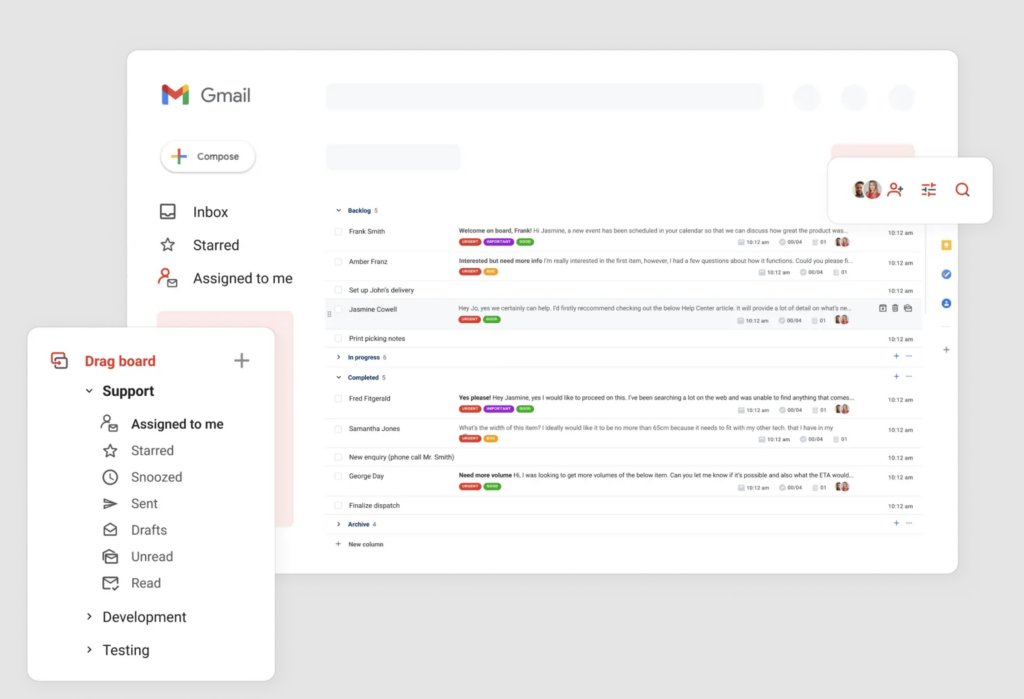
Key Features:
- Shared Email Drafts: Collaborate effortlessly on email replies. With shared drafts, you can write a response and have a teammate review or tweak it before hitting send.
- Activity Log: Stay on top of every action with a detailed activity log. You can see the full history of what’s happened on a board or a specific card, like who assigned a task, when it was updated, or what changes were made. This helps you track progress and quickly understand what needs attention.
- Email Sequences: Automate your follow-ups and save time. DragApp lets you schedule personalized email sequences, so you don’t have to manually send reminders or follow-ups. Once set, the system takes care of it, making sure no opportunity is missed.
Pricing:
DragApp offers three pricing plans to fit different needs. The Starter plan costs $8 per user/month, the Plus plan is $14 per user/month, and the Pro plan is available for $20 per user/month.
3. Zendesk
Zendesk is a cloud-based customer service platform that can work as a good alternative to Google Collaborative Inbox. While the Collaborative Inbox helps teams manage shared emails, Zendesk goes a step further by offering a more complete solution for handling customer support across various channels. But keep in mind that it’s quite expensive.
At its core, Zendesk uses a ticketing system that helps support teams keep track of customer questions and issues. When a customer reaches out—whether by email, chat, or social media—Zendesk creates a ticket that agents can follow up on. This way, everyone on the team can see what’s been done and what still needs attention, making it easier to provide consistent and timely support.
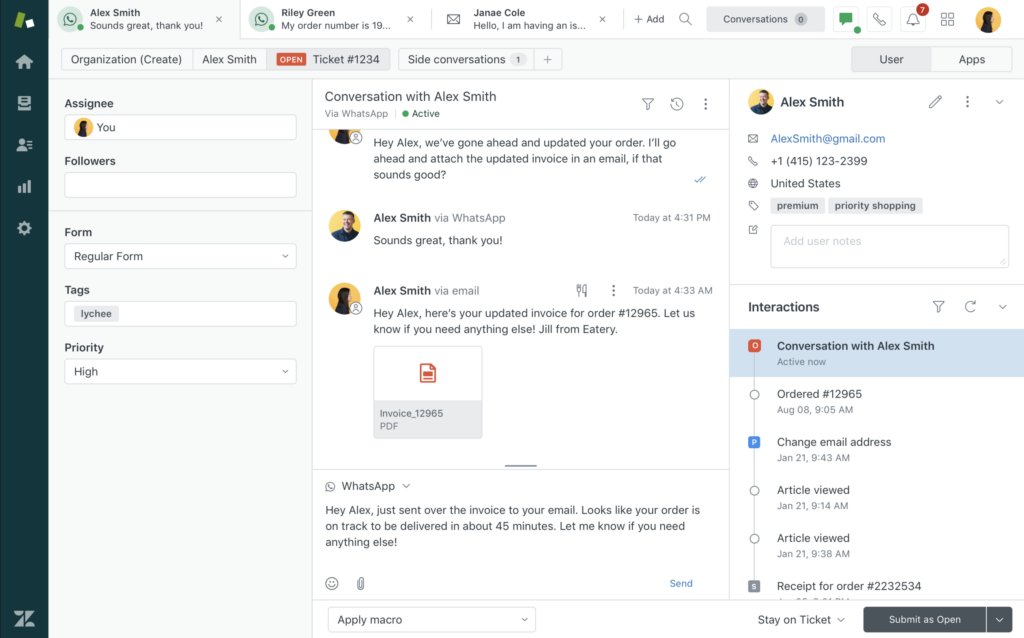
Key Features:
- Messaging: Build stronger relationships with customers by connecting with them through personalized, timely interactions. Provide instant help on your website, mobile apps, social media, or other business channels. With Zendesk bots, you can automate responding to commonly asked questions so that customers never have to wait.
- Zendesk AI: Zendesk’s AI feature includes an “Agent Copilot” that offers proactive assistance for support staff when they interact with customers. The AI can suggest responses based on the customer query and even help automate routine tasks like routing tickets.
- Collaboration: Collaborate with anyone – whether they’re inside or outside your company – in a separate thread directly linked to the main ticket. Also, keep internal conversations neatly separated from external conversations.
Pricing:
Zendesk offers four pricing plans to suit different business needs. The Suite Team plan starts at £45 per agent/month, while the Suite Growth plan is priced at £75 per agent/month. For more advanced features, the Suite Professional plan costs £89 per agent/month. If you’re looking for a customized solution, the Suite Enterprise plan is available—just get in touch with their sales team.
4. Front
Front offers a collaborative platform to manage emails – and its interface is very similar to that of any inbox. Teams using Front can share, assign, and collaborate on emails with ease. This is especially useful for those that want to avoid using CCs and BCCs in emails.
But unlike Google Collaborative Inbox which focuses primarily on managing shared emails, Front integrates various communication channels—such as email, chat, SMS, and social media—into a single, unified inbox.
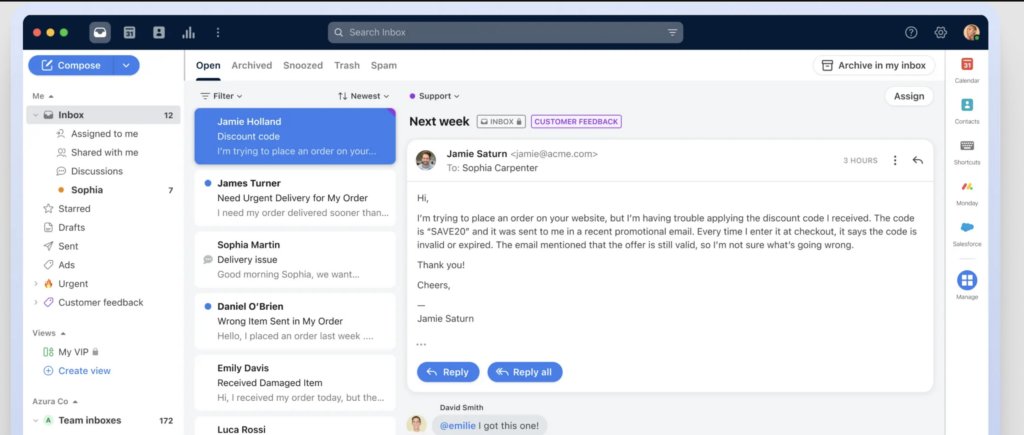
Key Features:
- Collaborative Drafting: Teams can collaborate on responses directly within Front by using shared drafts. This allows multiple team members to work together on a reply without needing to switch to another tool.
- Internal Comments: Front enables team members to comment internally on customer messages. This feature allows for behind-the-scenes collaboration without the customer seeing any internal discussions.
- Clear Ownership Assignment: Front helps team managers/supervisors assign ownership of conversations to specific team members based on their availability and expertise. This feature clarifies who is responsible for each inquiry, reducing confusion and ensuring that every message gets a timely response.
Pricing:
The Starter plan begins at $19 per seat/month, while the Growth plan is available for $59 per seat/month. Their most popular option, the Scale plan, costs $99 per seat/month. For more advanced features and customization, you can contact their team to learn about the Premier plan.
5. Help Scout
Help Scout is a customer service platform that facilitates smooth internal collaboration on queries, issues, and requests. Compared to Google Collaborative Inbox, it’s a lot more intuitive and feature-rich for managing customer communication.
The platform incorporates AI tools to assist teams in crafting better responses and answering common questions faster. But it’s designed in such a way that support staff don’t lose the human touch when interacting with customers.
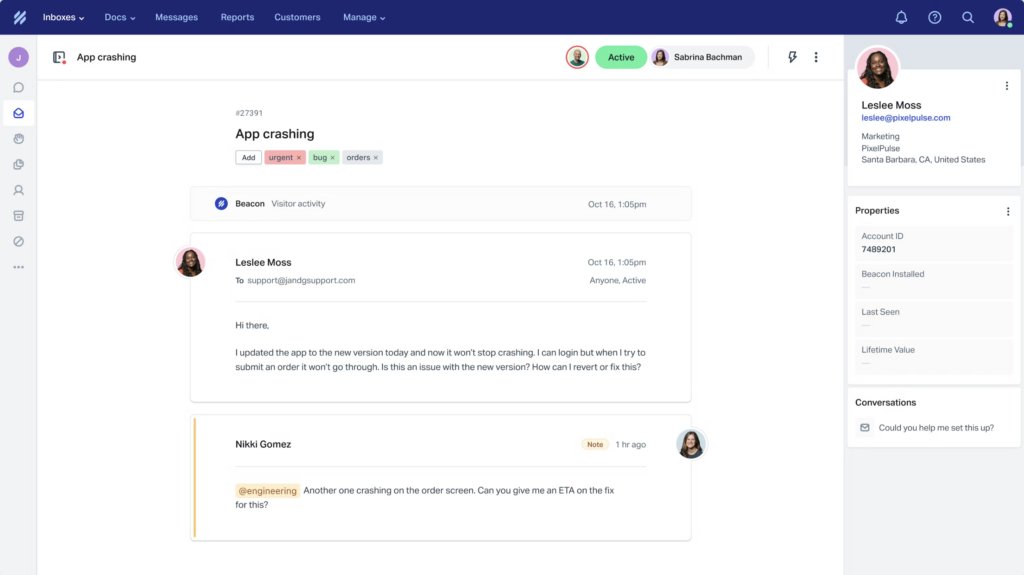
Key Features:
- AI Answers: Help Scout includes an AI-powered self-service assistant that provides instant answers to common customer questions. This feature taps into your knowledge base to help customers find information 24/7, reducing the volume of inquiries your support team needs to directly handle.
- Private Notes: The platform supports collaboration among team members through shared notes and internal comments on customer tickets. This allows agents to discuss emails without the customer seeing the internal conversation, ensuring well-informed responses.
- AI Summarize: This AI feature quickly generates bullet point summaries of lengthy email threads, enhancing efficiency for service teams.
Pricing:
Help Scout offers a free plan that supports up to 50 contacts per month with unlimited users. For larger teams or more advanced features, their paid plans start at $55/month per user for the Standard plan and $83/month per user for the Plus plan.
Frequently Asked Questions (FAQs)
1. How much does Google Collaborative Inbox cost?
Google Collaborative Inbox is free for users who have a Google Workspace account. Simply put, if you’re already subscribed to Google Workspace, you can use this feature without any additional charges. However, in case you want a custom domain for your group email address, you will need a paid Google Workspace plan.
2. What is the difference between Google Groups and Shared Inbox?
Google Groups is a product of Google that allows users to create groups for discussions and sharing information. A Shared Inbox, on the other hand, enables team members to access and manage emails from a common email ID. While Google Groups can serve various purposes (like forums or mailing lists),a shared inbox aims to help teams manage emails in a collaborative manner.
3. Can I assign conversations to specific team members in Google Collaborative Inbox?
Yes, one of the main features of Google Collaborative Inbox is the ability to assign conversations (or topics) to specific group members. This helps streamline workflow by ensuring that each inquiry is directed to the most appropriate person.
4. Is there a limit on the number of members in a Google Collaborative Inbox?
There is no specific limit on the number of members who can be added to a Google Collaborative Inbox. However, the overall limits depend on your Google Workspace plan. Generally, larger plans allow for more users and greater storage capacity.
5. Does Google Collaborative Inbox integrate with other tools?
Google Collaborative Inbox has limited integration capabilities compared to its alternatives like Hiver, Zendesk, Front and DragApp. While it works well within the Google Workspace ecosystem, it does not offer extensive integrations with third-party applications like CRMs or task management tools. Owing to this, it becomes difficult to sync data from Google Collaborative Inbox to other tools and this leads to more back and forth.
6. Is Google Collaborative Inbox suitable for customer support or sales teams?
Google Collaborative Inbox is pretty handy for managing team emails. But it has significant limitations for customer support or sales. Features like reporting, automation, and integrations are missing. It’s difficult to gain visibility into everyday workload or track all incoming queries diligently. Alternatives like Hiver, Zendesk, or Front are better suited for these use cases.
Your Team Deserves Better Than Google Collaborative Inbox!
In a nutshell, Google Collaborative Inbox might not cut it if you’re using it for teams like sales and customer support. You need a tool that offers:
- An intuitive user interface
- Powerful collaboration features
- Complete visibility into everyday workload
- Insights into conversation volume, response quality and team performance.
But hold on a second, Google Collaborative Inbox is free. Would switching to another tool mean that you have to invest a lot of money?
Well, absolutely not. Take Hiver, for instance. It has a forever-free plan that allows you to setup a shared inbox so that you can easily assign, track, and collaborate on all incoming emails. Get started now!

































